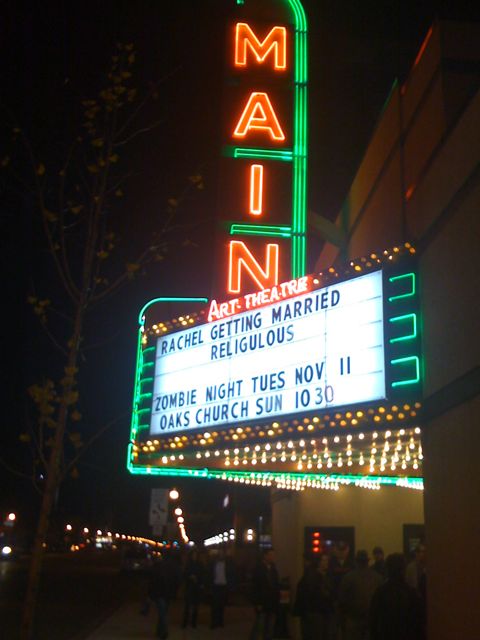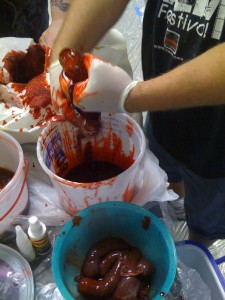Add to the lengthening list of the many business I would not want to be in at the moment this: Funeral homes. Their profit margin — fancy caskets, spare-no-expense funerals — is swirling down the drain with everything else.
It’s the damn boomers, of course, who ruin everything they touch. At Thanksgiving, we had a brief discussion of what we wanted for our last tribute on earth, and neither Alan nor I want a fancy funeral. Frugal Midwesterners we are (soon to be broke Midwesterners), we ask for nothing more than immediate cremation followed by some sort of meaningful dispersal of ashes. (The church of my birth would strenuously object to the scattering part, but I left that building a while back. The thought of my corpse being pumped full of chemicals and laid out for public display grosses me out far more, so that’s that.)
Of course, others have more ambitious plans:
The Royal Shakespeare Company will no longer use the real skull of Polish pianist Andre Tchaikovsky in its performance of Hamlet when it transfers to West End as it is “too distracting for the audience.”
The use of the skull had been kept a carefully guarded secret throughout the play’s four month run in Stratford until leading man David Tennant disclosed that the skull belonged to the late pianist Andre Tchaikovsky – who bequeathed his skull to the RSC for this very purpose.
Andre Tchaikovsky left his skull to the RSC in 1982 after he died of cancer to be used on stage in Hamlet. It took a quarter of a century to happen – and he posthumously appeared as Yorick in the recent production of Hamlet at Stratford.
Tchaikovsky — no word on relation to Pyotr Ilyich — always hated productions where they used a prop for the Yorick scene, his agent said:
“He hated the way it was done. When he saw (Hamlet) with the RSC, he (Andre) said, ‘I am going to leave my skull to the RSC, they really should have a proper skull. It doesn’t work with the plastic thing they have.’ And then we looked at his will, and there it was.”
Back into the prop warehouse for the late pianist; maybe in another 25 years they can bring him out again. If the bigmouth actors can keep their yaps shut, that is.
And so we begin all-bloggage Wednesday here at NN.C. But it’s beefy bloggage:
Remember how I told you you should be reading Roger Ebert’s blog? If you were listening, you already read today’s riposte to critics who accused him of not reviewing “Expelled,” the anti-evolution “documentary.” If not, baste in its sweet, sweet revenge here:
The more you know about evolution, or simple logic, the more you are likely to be appalled by the film. No one with an ability for critical thinking could watch more than three minutes without becoming aware of its tactics. It isn’t even subtle. Take its treatment of Dawkins, who throughout his interviews with Stein is honest, plain-spoken, and courteous. As Stein goes to interview him for the last time, we see a makeup artist carefully patting on rouge and dusting Dawkins’ face. After he is prepared and composed, after the shine has been taken off his nose, here comes plain, down-to-earth, workaday Ben Stein. So we get the vain Dawkins with his effete makeup, talking to the ordinary Joe.
I have done television interviews for more than 40 years. I have been on both ends of the questions. I have news for you. Everyone is made up before going on television. If they are not, depending on their complexions, they will look sunburned, red-splotched, oily, pale as a fish belly, orange, mottled, ashen, or too dark to be lighted in the same shot with a lighter skin. There is not a person reading this right now who should go on camera without some kind of makeup. Even the obligatory “shocked neighbors” standing in their front yards after a murder usually have some powder brushed on by the camera person. Was Ben Stein wearing makeup? Of course he was. Did he whisper to his camera crew to roll while Dawkins was being made up? Of course he did. Otherwise, no camera operator on earth would have taped that. That incident dramatizes his approach throughout the film. If you want to study Gotcha! moments, start here.
It weighs in at about a million words, each one as sweet as candy. Bon appetit.
How often have you sat through a meeting at your workplace — Six Sigma blah blah blah pursuit of excellence blah blah blah best practices blah blah to the blah — and yearned for something…more? Thought, “the writer’s life for me!” and considered jumping out the window, or maybe walking out the door? If so, let me introduce you to the closest equivalent to a copy desk staff meeting, “The Right Word” blog at the NYT:
Careful readers, including some in the cement industry, are quick to point it out when we confuse cement and concrete.
What’s the difference, you say? Go back to kindergarten, bonehead. From the NYT stylebook:
cement. Use concrete instead to mean the material that forms blocks, walls and roads. One ingredient is cement, the binding agent that is mixed with water, sand and gravel.
You can almost hear the voice of Ben Stein, can’t you? Click through for more exciting hair-splitting over “podium” and “lectern.”
(All snark aside, I do think these distinctions are important, and I recognize the importance, and thanklessness, of the job of maintaining language standards. I only question whether the public gives enough of a fig to make it part of the NYT’s website.)
From the WashPost, a sobering story on how technology makes a better terrorist:
The heavily armed attackers who set out for Mumbai by sea last week navigated with Global Positioning System equipment, according to Indian investigators and police. They carried BlackBerrys, CDs holding high-resolution satellite images like those used for Google Earth maps, and multiple cellphones with switchable SIM cards that would be hard to track. They spoke by satellite telephone. And as television channels broadcast live coverage of the young men carrying out the terrorist attack, TV sets were turned on in the hotel rooms occupied by the gunmen, eyewitnesses recalled.
This is terrorism in the digital age. Emerging details about the 60-hour siege of Mumbai suggest the attackers had made sophisticated use of high technology in planning and carrying out the assault that killed at least 174 people and wounded more than 300. The flood of information about the attacks — on TV, cellphones, the Internet — seized the attention of a terrified city, but it also was exploited by the assailants to direct their fire and cover their origins.
Fascinating story.
If you prefer gunplay more relaxed, less deadly and a whole lot funnier, try this piece on Detroit’s last surviving inside-the-city-limits gun store, written by the Metro Times’ own Detroitblogger John. (I’m reliably told the pseudonym protects an actual reporter for the more smugly self-satisfied of the city’s dailies, and why these excellent little sketches of city life aren’t running there is anybody’s guess, but I’d guess it comes down to the suicidal standards of corporate journalism.)
Anyhoo, some great detail about the dangers of ricochet on the indoor range:
He unconsciously shields his groin with his hand as he talks. “A woman was shooting, and I got hit right on the head of my dick!” he says. “But it didn’t hurt. It just come and fell. So about two, three months later a lady’s down here shooting, the damn bullet ricocheted, hit my damn dick. I said ‘What the hell’s going on here!'”
And finally, what the hell is going on here? General Motors needs $4 billion in cash just to get through the end of the month. Anyone want to buy a nice house in Grosse Pointe? I could probably make you a deal.
Off to whistle past the graveyard. Happy Wednesday.

